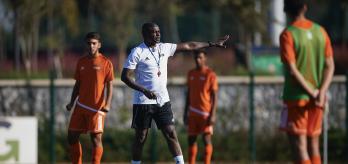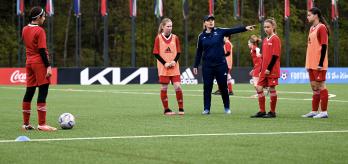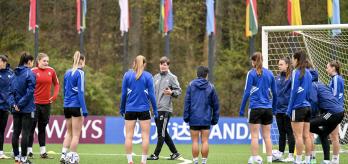The mid-press is possibly one of the most effective ways of ensuring a team has a good level of control even if they don’t have the ball. By dropping into a compact shape, and only pressing once a team progresses the ball into the middle third, a team can significantly limit the opposition’s possibilities of working the ball into dangerous areas.
In this session, Grasshopper Zurich Club Women’s Head Coach, Anne Pochert, delivers a series of activities that hone players’ abilities in a mid-press. The session begins with a warm-up, followed by a ball-circulation exercise that introduces the basics of a mid-press. Part 2 focuses on the movement of the mid-block and how the team can stay compact, whilst the final exercises put the mid-press into practice.
Session overview
Key coaching points
-
Players maintaining a compact shape and closing distances between players to prevent the opposition from progressing the ball into dangerous areas.
-
Players pressing when the opposition passes or approaches the mid-third rather than engaging high up the pitch.
-
Players shuffling across as a unit and closing gaps whenever the opposition moves the ball from side to side.
-
After a press has been attempted, players immediately drop back into their positions in the mid-block shape.
Part 1: Ball circulation with press
This first exercise sets the tone and tempo for players pressing in a mid-press. The idea is for players to get comfortable with the strategy of waiting for the ball to move forward before pressing quickly.
-
Mark out two red cones 10m apart.
-
Place a blue cone 5m on the outside of both red cones.
-
In the middle of the two red cones and 2m behind, position another red cone.
-
Place a blue cone 5m further back from the middle cone in the centre.
-
Mirror this cone formation 10m on the other side.
-
Split the group into two teams of six.
-
Position the players so that there is one player per cone. Orange players on the red cones, blue players on the blue cones.
-
Going anti-clockwise, the blue players must pass the ball to the player at the next cone.
-
As the ball is travelling, the orange players at the red cone must become active and press the player in possession.
-
As soon as the player who receives the ball moves the ball away, the player who was pressing relaxes and moves to the blue cone they were pressing.
-
The player who made the pass moves to the red cone.
Variation 1
-
The players that are pressing must now press before the ball has left the passer’s foot.
Variation 2
-
Pass the ball clockwise.
Variation 3
-
Play with two balls in circulation to increase focus and intensity.
-
Play the ball anti-clockwise again.
-
Open the angle and create distance from the pressing player by dropping 2m from the cone just as the passing player is receiving the ball.
-
The receiver’s first touch should always be out of their feet and in the direction they intend to play it.
-
Pressing players must pay attention to the triggers of when to press. For example, when the ball leaves the passer’s foot.
-
When pressing, players should dart toward the receiver as quickly as they can.
Part 2: Mid-block game
This second exercise focuses on the movements of the mid-press as a unit. Players must understand when it is their turn to step out of the line to close distances, as well as maintain good distances between one another.
-
Mark out a 30m x 30m area.
-
Split the area into three equal zones (10m long).
-
Split the group into three teams of four (blue, orange and green).
-
The blue team are positioned in the first zone.
-
The orange team are positioned in the mid-zone.
-
The green team are positioned in the end zone.
-
The ball starts with the blue team in the first zone.
-
They must try to find a passing angle and successfully pass to the green team in the end zone.
-
The orange team in the mid-zone must stop the pass from reaching the end zone.
-
If the blue team successfully make the pass, the green team must do the same and try to return the ball to the blue team.
-
If the orange team block the pass, the ball restarts with the team at the opposite end to where the pass was attempted.
-
Players cannot leave their respective zones.
-
One player from the first zone enters the mid-zone and tries to help progress the ball to the end zone.
-
The player can move freely inside this zone and can play backwards as well as forward.
-
When the ball successfully reaches the end zone, a player from the end zone goes into the mid-zone and the player from the first zone returns.
-
Players staying compact and maintaining distances of 2-3m between each other to ensure gaps are kept to a minimum and reduce the possibility of passes being played through the mid-zone.
-
Players that are directly facing opponents stepping out of the mid-zone line to close distances and ensure the ball stays in that zone. This should be followed as the ball moves along the zone.
-
Players keeping the ball moving at all times to create a gap to pass through.
Part 3: 6v6 game
The session ends with a 6v6 game that focuses on the structure and shape of the mid-press as the opposition moves the ball from defence into attack. The players operating in the mid-press must stay compact and engage the opposition only when they come forward.
-
Mark out a 60m x 50m pitch.
-
Position a full-size goal with a goalkeeper at one end.
-
At the other end, use two cones to create a channel in the centre of the pitch.
-
Position a makeshift goalkeeper in front of this channel.
-
10m further forward from this channel, mark out a 5m-wide channel on either flank of the pitch.
-
Split the players into two teams of six.
-
The blue team play toward the channels.
-
The orange team play toward the full-size goal.
-
The ball starts with the goalkeeper from the blue team.
-
The blue team must build-up play and either play through the wide channels or pass to the makeshift goalkeeper in front of the central channel.
-
The orange team must use a mid-press strategy to prevent the ball from being played through.
-
If the orange team wins the ball, they must attack the other goal
-
Remove the channels and cones and play a free game on a 75m x 50m pitch.
-
Add a second full-size goal and a goalkeeper.
-
If the blue team switches play from one side to the other and then scores, they gain 2 points.
-
Players maintaining a compact structure when using the mid-press to prevent passes from being played into the central areas where it can disrupt the structure.
-
Players moving as a unit from side to side and maintaining short distances between each other when following the opposition’s switches of play.
-
Players approaching the player in possession from an angle that shuts off passing lanes, as this can increase the chances of forcing a turnover of possession.
-
Letting the centre-backs pass between themselves but as soon as they move forward, engaging them to force them back or wide.





















